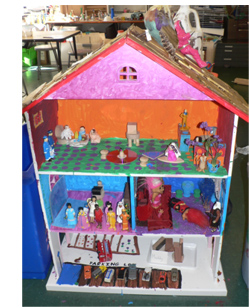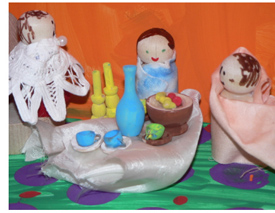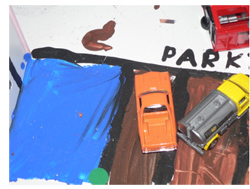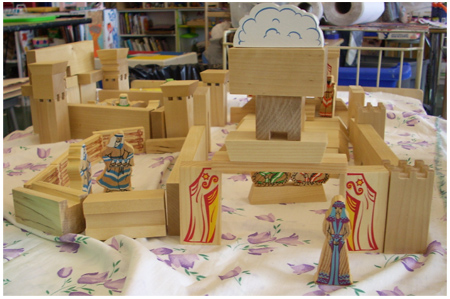 What makes a house a Jewish home?
What makes a house a Jewish home?
This question is frequently posed to children in religious school settings. What follows, generally, is a list that includes stuff like Shabbat candlesticks, a hanukkiyah, a mezuzah, a Seder plate. Usually, the longer the list, the more satisfied are the students and teacher. Yet, I would argue that these implements, used in the course of Jewish living, do not constitute the essence of a Jewish home, any more than a Star of David constitutes Jewish art.
My intuition in this regard was bolstered last week while I watched my students play in our dollhouse. Yes, our art studio has a dollhouse! No small shelf item, our dollhouse is about 3½ feet tall and catches the eye of everyone who enters the room.
The dollhouse started life as a white bookshelf with a peaked pink roof that I picked up on sale at Target. Since then, the original bookshelf has undergone a remarkable transformation. After first re-roofing, various groups of children and individuals have undertaken to paint and wallpaper rooms, fashion furniture, and give birth to doll families. Two weeks ago, the “dinner table” was set with diminutive bowls of soup and Shabbat candlesticks. A doll family was placed around the table.
 Our bookshelf, turned dollhouse, became a Jewish doll-home, not by virtue of the candlesticks, but as a result of the collaboration of many students, of every age, who invested their hearts in the effort. Creating this doll-home fostered a culture of discussion, of consideration, of compromise and of respect.
Our bookshelf, turned dollhouse, became a Jewish doll-home, not by virtue of the candlesticks, but as a result of the collaboration of many students, of every age, who invested their hearts in the effort. Creating this doll-home fostered a culture of discussion, of consideration, of compromise and of respect.
Children’s play generates learning that no worksheet can match. Roofing the house led to lessons on what the Torah teaches about safety (constructing a parapet around your roof), stuffing tiny sofa cushions involved thought of ways we offer comfort. The addition of a bathroom on the top floor was a reminder of our daily blessings. One afternoon, a 2nd grader painted a parking lot on the bottom floor and, before I knew it, we had a blue space with an innovated wheelchair icon, along with lessons about what the Torah means by the words ‘stumbling block.’
 Perhaps the sweetest lesson of our Jewish doll-home is the one that speaks to the future. I was a privileged eavesdropper on a conversation, between a 4th grader and some younger students, who questioned the type of paint they should be using on the “bedroom” walls. The 4th grade ‘teacher’ explained patiently that permanent paint was not needed. “You see,” she said. “When we are older, like in middle school, younger kids will want to design this house their own way. They will see what we have done, and they will add to it and decorate over it.” I do not think that Honi himself could have taught a better lesson while planting his carob tree.
Perhaps the sweetest lesson of our Jewish doll-home is the one that speaks to the future. I was a privileged eavesdropper on a conversation, between a 4th grader and some younger students, who questioned the type of paint they should be using on the “bedroom” walls. The 4th grade ‘teacher’ explained patiently that permanent paint was not needed. “You see,” she said. “When we are older, like in middle school, younger kids will want to design this house their own way. They will see what we have done, and they will add to it and decorate over it.” I do not think that Honi himself could have taught a better lesson while planting his carob tree.
Our art studio has many toys. We have tent blocks for Avraham, Sarah and their visitors. Children manipulate the Sarah and Avraham block figures, conducting numerous conversations with their angelic visitors, practicing their Hebrew vocabulary and reenacting their parshiyot learning. The Beit haMikdash blocks are favorites. Sometimes they team up with the Sarah and Avraham blocks. The blocks are never reconstructed according to the boxed instructions. Our blocks are arranged, as needed, to complement the day’s storyline. What sacred task might be engaging our wooden Kohanim figures? My older students clamor to tell me, showing me their innovation, grabbing the classroom Chumash to validate their scenario.

With Purim on the horizon, my puppets will come out. Soon, student hands will wear Queen Esther, King Ahasueros, Haman and Mordecai, with voices reenacting the Megillah. This kind of puppet play will precede and invigorate students’ own Purim puppet creations, masks to be created to explore the emotions in the Megillah and paintings of Shushan with their collaborating artist statements.
I would like to invite you to begin your Spring, holiday, teaching with play. Build, act and imagine your way through the learning. Allow students to lead you to the hands-on experiences that will solidify and imprint the important lessons. I challenge you to set aside your anticipated class sets of crafts. Endow your students with the responsibility, and the honor, of guiding you to the art adventures through which each individual child will blossom in their knowledge!

